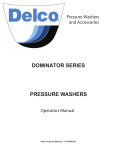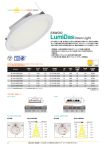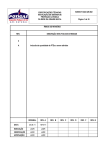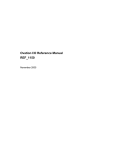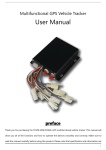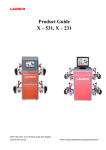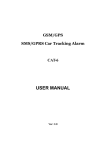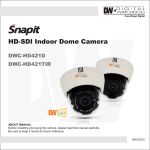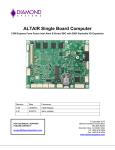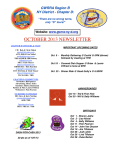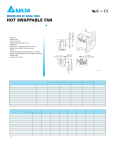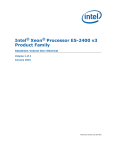Download 21.External Plant
Transcript
Compiled by AIGETOA Chennai ( www.aigetoachtd.org ) External Plant and Access Network OBJECTIVE TYPE QUESTIONS UNDERGROUND CABLES- TYPES 1 The conductors used in UG cables High Conductivity Annealed copper conductors with round shape . 2 The Diameter of CU conductors used in UG Cables 0.40 mm/ 0.51mm/ 0.63 mm/ 0.90mm 3 The Types of Insulation a) Paper- LSDC and Composite Sheathed Cable b) Polythene- In PIJF cables 4 Purpose of Insulation a) To insulate – Physical separation and Electrical Separation between Cu conductors b) For colour code Identification of Cable pairs 5 The lay and overlapping of cable pairs are so chosen to To satisfy capacitance unbalance requirements and to prevent X Talk 6 In PIJF cable the Moisture Barrier used is Petroleum Jelly 7 In LSDC ( Lead Sheathed Dry Core Cable) The Insulation is Paper, The Sheath is Lead 8 In PIJF ( Polythene Insulated Jelly Filled) The Insulation is Polythene, The Sheath is POLY-AL 9 The Mechanical protection in UG Cable 2 Layers of Steel / GI Strips known as ARMOURED cable 10 Cable Without Steel Tapes are Unarmoured Cables To be used in DUCT Laying ( Primary sizes) 11 The Higher Dia Conductor > 0.51mm is used for Long Distance Lines Compiled by AIGETOA Chennai ( www.aigetoachtd.org ) 12 Paper Insulated Cables PCUT- Paper Core Unit Twin- used for Local Subscriber Network PCQL- Paper Core Quad Local- Used for Junction Network between 2 Exchanges- minimum Dia 0.63mm PCQT- Paper Core Quad Trunk- used for Trunk CircuitsMinimum Dia 0.63 mm PCQC- Paper Core Quad Carrier- Used For Carrier Circuits- 13 Quad- 4 Conductors are twisted in a single operation in such a way that conductors forming one pair is opposite to each other to avoid X Talk 14 PIJF COLOUR CODE In a 20 pr PIJF the Mate colours used are White Mate- Pairs 1-5, Red Mate- 6-10, Black Mate 11-15 and Yellow Mate-16-20 15 Colour Code Pair No 18 in a 20 pair= Yellow- Green 16 50 Pair = 5 x 10 pair Units Colour Binder for Unit No 1- Blue (1-10) 2-Orange 11-20 3-Green 21-30 4- Brown 31-40 5 – Slate/ Grey 41-50 17 100 Pair = 5 X 20 pair Units Unit No 1- Blue 1-20 2- Orange 21-40 3 – Green 41-60 4- Brown 61-80 5 –Slate/ Grey 81-100 18 200 pair = 4 Super Units x 50 pair 400pair = 8 Super Units x 50 pair Compiled by AIGETOA Chennai ( www.aigetoachtd.org ) 19 Colour Binder For Super Units First SU – Marker- RED Binder Last SU - Reference- BLACK Intermediate - WHITE Binder 20 More Than 400pair cables are divided into 100 pair SU 800 = 8 SU x 10 pair 2400= 24 SU x 100 pair 21 Pair Gain systems are introduced in Local Network, to provide Temporary relief to TNF Technically Not Feasible Areas where Cable Pair Scarcity is there. 22 Advantages of PIJF cable PCM, Coaxial 1 PCM cables were used for JUNCTION working 2 Sizes of PCM Cable 10+2/ 0.63mm, 20+4, 48 +6 and 96 +8 3 The Diameter of Conductor of PCM Cable is - 0.63 mm only 4 The Aluminium Screening bisecting the Cable Core in PCM GO pair and RETURN Pair of a system will be Loaded on either side of Screening to avoid X talk 5 Co axial Cables were used for LONG DISTANCE NETWORK 6 Types and Sizes of Coaxial 174 Coaxial- Small Tube- 2 Core 4 Core 375 Coaxial – Large Tube- 2 Core 4 Core 7 174 CXL means – The Inner Diameter of outer CU Tube is 0.174 inches. Similarly for 375 also. Compiled by AIGETOA Chennai ( www.aigetoachtd.org ) 8 In CXL , Interstice Quads/ Pairs with Cdr Dia of 0.9 mm is available for INTERSTICE Working 9 Polythene Discs placed at Uniform Intervels of 2 inches apart, separates the Inner Solid Conductor and Outer CU Tube in CXL Cables CABLE LAYING 1 Depth of Local Cable Trench- 100 cm (3‟3”) - 30 cm - 1‟ Width 2 Horizontal Separation between Telecom Cable and Power Cable Not Less than 60 cm. 3 The Angle of crossing of Telecom amd Power cable is 90 degrees. 4 At crossing with Power cables the Telecom cable should be Laid SOLID with BITUMEN for 90 cm on either side. 5 Methods of Cable Laying a) Laying Direct Burial by excavating Trench b) Solid Laying- Bitumen / Concrete c) Duct Laying- PVC Duct Nest & Unarmoured Cables. 6 At Road Crossings use - RCC pipe / GI At Bridge / Culverts At Railway Crossing- 7 - GI pipe with cement Concrete CI Cast Iron Pipe / GI Where Solid Laying is done 1. Inadequate clearance between power cable and Telecom cable- Bitumen Solid Laying 2. At the Leading in / Leading Out points of Bridge/ Culverts- With GI pipe and Cement Concrete 8 In case of Road cutting Permission ids denied Thrust Boring ( Sideways Boring) to be adopted to negotiate the road 9 Placing of Warning Bricks: For one cable: Longitudinally- 4.4 Bricks per metre More than one cable- Transversely- Compiled by AIGETOA Chennai ( www.aigetoachtd.org ) 10 What are the steps involved in Cable Laying 1. Survey of Cable route 2. Decide the side of the road 3. Marking of Cable Trench 4. Excavation of Cable Trench as per the standards 5. Inspection Cable Trench for its Depth and Alignment 6. Approval of Trench for Laying Cable 7. Laying of Cable as per standards ( Use Cable Rollers inside Trench) 8. Placing of Warning Bricks 9. Closing Cable Trench 10. Ramming Of Cable Trench 11. Making Cable History with Route Index Digaram 11 What is Dial before Dig service 12 What is the use of Flooding of Cable Trench 13 Shortest Cable Route must be selected 14 The Arrow mark on Cable drum denotes the Direction of Rotation of the Drum CABINETS, PILLARS & DPs 1 Cabinets/ Pillars are Partial Flexible Points 2 Sizes of Cabinets/ Pillars – Old Type – Not used now 300 pr/ 500/ 700/ 1000/ 1400 pairs 3 Sizes of Krone Type Pillars- Used now 800 pairs/ 1000/ 1600 and 2000 pairs 4 Old Type: Cable from Exge MDF to Cabinet- Primary Cabinet to Pillar - Secondary Pillar to DP - Distribution Compiled by AIGETOA Chennai ( www.aigetoachtd.org ) 5 Krone Type Pillars- No Cabinets are used now Cable from Exge MDF to Pillar- Primary Pillar to DP- 6 Distribution CT Boxes are Cable Terminal Boxes where Cables either from xge or Cables to DPs are terminated Exge side CT Box- Primary cable is terminated DP side CT Box- Distribution cables are terminated 7 Conventional Type CT Boxes: ( Not used now) Screw Type Terminals are available CT Box sizes- 50 pair / 100 pair Single Inlet / Double Inlet type 8 Types of CT Box wiring: A Type- Single Inlet CT Boxes are used, Ct Box will be terminated either with Xge side or DP side Cables only 9 B Type- Double Inlet CT boxes are used EX: In a 100 pr Double Inlet CT box, 50 pr Left side is for Xge side cable and 50 pair ( Right) DP side cable Exge side terminals and DP side terminals appear side by side. No Jumpering required. Metal Strap will be provided from Xge side to DP side 10 C Type Wiring: 100 pr Double Inet will take 100 pr xge side and 100 pr DP side. Alternate 5 pairs on xge side and DP side will be thro Connected at the Bottom of Pillar and remaing pairs will be terminated on CT boxes. Here also Metal Straps will be provided 11 C Type Tip Jointing: „C‟ Type CT box can be converted into „A‟ Type by Tip Jointing the Exge side cable Tail 12 Krone Type CT Boxes: Here a CT box is terminated either with Xge Side or with DP side Compiled by AIGETOA Chennai ( www.aigetoachtd.org ) cables only- Hence „A‟ Type wiring only in Krone CT Boxes 13 In Krone type CT box cables are terminated with KRONE TOOL- LSA PLUS Tool- NO stripping of wire, NO termination and NO Soldering 14 IN Krone CT Boxes the counting of circuits is from Top to Bottom and from Left to Right 15 In Krone CT Boxes the permanent Cable wiring is done on Top side of the Module 16 The Jumpering is done at the Bottom side of the module 17 In Krone CT box, pair No 88 is available at 9th module from the top and 8th cct from Left 18 Position and Counting Of CT Boxes A1, A2, B1 , B2 …………………………… E1 , E2 Ex: D2 CT Box; E1 CT Box 4 th Row from the top and 2 nd Ct box from Left 5 th Row 1 st from left 19 Jumpering will be done only thro Jumper Rings 20 Cabinets are numbered from 01-20 Pillars are numbered from 21-99 Nowadays since there is no use of cabinets, Pillars are numbered from 01-99 21 Main features of Krone Tool and usage of parts- 22 The Inner Zone area is covered by a radius of 500 metres from Xge Here there will be NO pillars- DPs are directly erected from MDF 23 Rigid System of Cable Planning- Less than 500 lines xge Cable section is from MDF to DP. – No Pillars in between 24 Flexible system of Planning- More than 500 Lines Here Pillars are introduced in between MDF & DP 25 DPs Type: External DP 10/ 20 pair Internal DP Wall mounting 5 pr Dp ( PoleLess) 26 Minimum Height of Extl DP - 9 Feet Compiled by AIGETOA Chennai ( www.aigetoachtd.org ) Internal DP- 8 Feet Wall mounting – 140 cm ( 4 to 5 Feet) 27 DPs Numbering: 4 Digits Ex: 7707 – The first 2 digits 77 represents the Pillar NO from which DP is working, Next 2 digits 07 is Serial No of DP 28 Inner Zone DPs starts with 00 Ex : 0012- 00 Inner Zone, 12 Serial NO of DP 29 DP Clamps: Used at 3 places in a DP post to hold the DP post and GI pipe together- Bottom, Middle and Top 30 Explain DP Dressing and Rehabilitation of DP 31 Advantages and Dis advantages of Pillar System 32 In a 1000 pr Pillar Exchange side Primary pairs- 400 pr- 4 CT Boxes DP side Distributon pairs - 600 pairs- 6 CT boxes CABLE RECORDS 1 Maintenance of Cable records will help in Discovering and Localizing Cable faults and for Rehabilitation of Cable Network 2 Mention cable records to be Maintained: 1. Town Plan / Town Map 2. Exchange Area lay out Map 3. Primary/ Secondary Cable Diagram ( Single Diagram) 4. Cabinet / Pillar Lay out 5. Pillar Diagrams ( For each pillar, separate Diagram) 6. Junction Cable Diagram 7. Line/ Route index Diagram- for primary, Secondary and Distribution Cables – mentioning Route, Joint Locations geographically 3 Mention the Cards to be Maintained 1.MDF Card- Tag Block wise Compiled by AIGETOA Chennai ( www.aigetoachtd.org ) 2. Pillar Card- CT Box wise 3. DP cards 4. Subscriber Index Cards 5. Repeated Fault Card 4 What is Dial Before Dig Service 5 IN MDF , Counting is always from Bottom to Top 6 MDF verticals are numbered from 01 -99 from Non- Growing end Tag Blocks/ Connection strips are numberd from 00-09 from Bottom to top Ex; 157/ 22- 15 th vertical, Tag block No 7 and CCT No 22 7 What is CRMS? Cable Records Management System 8 What are the benefitsof CRMS? Refer Book 9 What is FRS? Fault Repair Service- Manual FRS/ Computerized FRS and DOT Soft FRS 10 While attending the Faults, The Lineman Should Go to the Subscriber Premises FIRST 11 Action to be taken on Repeated Fault Cases 12 What are the advantages of Computerized FRS compared to Manual FRS? DROP WIRE 1 Advantages of Drop wire 2 Drop wires – Self Supporting Dia of Cdr 1.25 mm and 0.91 mm Nowadays 0.51 mm DW are supplied 3 Accessories used for Drop Wire 1. Support Clamp with U Back- Can be fitted onto the bracket and can take 2 distribution Clamps Compiled by AIGETOA Chennai ( www.aigetoachtd.org ) 2. Drop wire Distribution Clamp- Made up of Reinforced Plastic Material- Thro this only DW will be taken- No friction/ Rubbing of DW 4 Distance between 2 support calmps on a Bracket- 20 cm 5 DW Joint should be done at a Fixture- here 2 distribution clamps are used for one DW Jt so that the Loose ends of DW to Be jointed are not strained by span lengh 6. On suspension of DW , One Distribution Clamp is used for one DW POLELESS NETWORK 1 What is Poleless and What is the size of cable used for this purpose 5 pair into the Subs Premises 2 5 pr cable is to be laid at Right angle 90 degrees to the Distribution cable 3 Cemented portion at Subs premises to be chipped for 6 inches depth and 2 inches width . cable will be laid inside 1 “ PVC pipe and then cement concreted 4 For tap joint only 3 inches of Distribution cable is to be remove and correct pair to be tapped leaving the other pairs undisturbed. 5 25 mm PVC Water pipe is to be used for bringing the 5 pr from Ground to the wall mounted DP at a Height of 140 cm 6 Number of pairs to be tapped from Distribution cable 1. For one connection- One Pair only 2. For 2 connections in a building- 2+1 = 3 pairs 3. For 3 / 4 connections in Building = 5 pairs 4. More than 4 Connections = 10 pair Intl DP APLAB DIGITAL CABLE FAULT LOCATOR- 3039 1 General Types of Cable Faults 1. Earth Fault Compiled by AIGETOA Chennai ( www.aigetoachtd.org ) 2. Low Insulation Fault 3. Break/ Disconnection 4. Short/ Loop 5. Foreign Potential 6. Dry Joint/ Corrission 2 Basic Requirements of Detection and Localization of Faults Refer 2.1 at Page 161 3 What is the voltage of Insulation Megger- 100 volts 4 Principle of working of Aplab Locator Pulse Echo method/ Pulse Reflection Method 5 What are the functions of various Knobs/ swiches Refer page 164 & 165 6 Purpose of Horizontal position knob Controlling Left to Right – Horizontal Movement of Curve/ Pulses 7 Vertical Position- Contrlling UP and Down Movement of pulses 8 Horizontal Expansion: Expanding the pulse/ Curve along X axis to have an accurate Display 9 Vertical Gain;- Controls the vertical amplification of the pulse to have a puse of sufficient height 10 The Fault pair is connected to- L1 Terminal 11 The Good Reference pair is connected to- L2 Terminal ( If Required) 12 How many Ranges are available: 0- 0.3 KM range- Both buttons not pressed 0 – 1 Km Range- First button pressed, II Button NOT Pressed 0 – 3 Km range- I Button Not Pressed, II button Pressed 0 – 10 KM Range – Both Buttons Pressed 13 What is the power Supply 12 – 15 Volts Nickal Cadmium Batteries External DC also can be connected 14 The V/2 Constant is different for different types of cable. V/2 is selected thro “Velocity Selector” – a Thumb Wheel Switch Compiled by AIGETOA Chennai ( www.aigetoachtd.org ) 15 V/2 Constants 1. Paper Insulated-104 2. Jelly Filled-88 3. PVC- 82 16 The Meter should Be earthed at Earth Terminal 17 If the Battery is LOW, RED LED will Glow – Low Battery Display 18 The Break Fault / Open CCT is denoted by the pulse with UPWARD Projection 19 The Short / Loop Fault is denoted by DOWNWARD Projection 20 The pattern of the Original/ Transmitted Pulse is - BREAK 21 The FOOT of the Original T pulse and the FOOT of the REFLECTED Pulse ( FAULTY PAIR) should be synchronised. Press the READ Button. The Distance to the Fault is displayed CABLE JOINTS 1 What is straight Joint- Ex: 100 pr to 100 pr 2 What is Branch Joint- Ex : 800 pair to 2 NOS of 400 pr 3 Jointing Closure Techniques used: 1. Lead Sleeve Plumbing Technique- LSDC cable 2. ALSS- Auxiliary Lead Sleeve – Composite sheathed. 3. XAGA 250 technique- PIJF cables- Thermo Shrink Filled Kits are used 4 Conductor Jointing: Paper Insulated Cable Conductors are jointed thru TWIST method with correct size PAPER SLEEVES 2 Paper sleeves are required for one pair. Here the Insulation to be removed, Conductors Twisted / Jointed and if Reqd Soldered ( More than 0.51 mm ) 5 PIJF: For jointing the pairs UY CONNECTORS / B Connectors / Compiled by AIGETOA Chennai ( www.aigetoachtd.org ) Buttons are used--- 2 Buttons are reqd for one pair- CRIMPING TOOL alone to be used splicing- Here NO removal of Insulation , NO Jointing and NO soldering 6 For Higher size PIJF cables > 200 pairs, MODULAR CONNECTOR – 20 Pair Strips are to be used- Here 20 pairs are arranged in a Modular strip colour code wise and they are jointed in a Single Compression of Modular Tool EX: For 400 pr Joint, 20 No of 20 pr strips are reqd along with Compression Tool 7 The UY connectors CAN NOT be used on Paper Cables 8 Plumbers Metal – Lead is used for wiping and sealing in Lead Sleeve Technique- LSDC Cables and CXL cables 9 IN ALSS plumbing Technique The Main Sleeve used is – 1 , Auxiliary Sleeves are- 2 The Main Sleeve is Plumbed over the Auxiliary Sleeves 10 Various sizes of TSF Kits for PIJF TSF 1, TSF 2 ……………………. TSF 7 11 Which Kit to be used on which size cable? Refer Book Ex : TSF 1- 20/.51, 20/.63 TSF 2- 20/.9 , 50/.63………… TSF 7 - More than 800 /.51 PIJF 12 What is TSR? Thermo Shrink RE-Entry Kit while attending Faults 13 Tools used in XAGA Technique 1. Crimping Tool for conductor jointing 2. Modified Blow Lamp or Gas Torch- Yellow flame with Moderate Temperature to be used for heating the Thermo Shrink Sheet 14 What is the purpose of Aluminium Cannister? 1. To give round shape to yhe Joint 2. TSF sheet will have more Grip and adhesiveness over Cannister 3. To some extent , it gives Mechanical Strength 15 Mention some Items in TSF KIT Compiled by AIGETOA Chennai ( www.aigetoachtd.org ) 1.CTC- Carbon Tetrea chloride Liquid for cleaning 2. Cable Filling Compound- Jelly 3. Sheath Continuity CU wires with Crocodile Clips at the ends 4. Emery Sheets for rubbing on the Cannister and Sheath 5. Metal Aluminium Cannister 6. Insulation Tapes 7.Thermo Shrink Sheet with Metal Iron Channel 8. Branch Clips 9.Mastic Adhesive Black tape for sealing at ends 10. Plastic Cover/ Sheet while cleaning and placing Filling Compound 16 While inserting the wires into UY Connectors, the wires should reach upto the Top Head of the Button 17 The Sheath / earth Continuity must be given on Aluminiam Foil of Inner Sheath to prevent damages due to Lightning/ Extrea High Voltages 18 Modified Blow Lamp/ Gas Torch with Yellow Flame to be used for heating TSF sheet. Heating to be started from centre and proceeded towards one end. No Air Bubbles to be present. The sheet should be heated till such time the Green Dots available on the sheet just disappears. DUCTED CABLE SYSTEM 1 Advantages Ducted system 2 Unarmoured DUCT cables only to be used in Ducted system 3 Diameter of pipes – PVC pipes of 4” Dia ( 102 mm to 105 mm) This will accommodate maximum size of primary cable 4 The number of pipes for each row is 5 Types of Ducting: 4 Sand Filled Ducting Concrete Filled Ducting 6 4 mm Nylon ropes to be drawn in PVC pipes. Compiled by AIGETOA Chennai ( www.aigetoachtd.org ) 7 The Depyh of the Top Most pipe is 60 cm on Foot Path and 80 cm in Traffic roads 8 The Types of Manholes 1. Straight Manhole – A Manhole 2. Turning Manhole- L Manhole 3. Branching Manhole- T manhole 9 Facilities to be provided in Man holes 10 Maximum size of Duct Nest: 11 The Distance between 2 Consecutive Manholes is 190 - 195 metres 48 Way ( 12 Rows X 4 Pipes ) so as to accommodate Joints at Manhole- Standard size of Drum is around 200 m for Big Size cables Joints will be placed on Support Frames on Side walls of Manhole and NOT On the Bottom Bed of Manhole in which case the Joint will be damaged 12 Planning Period of Duct is 20 years















